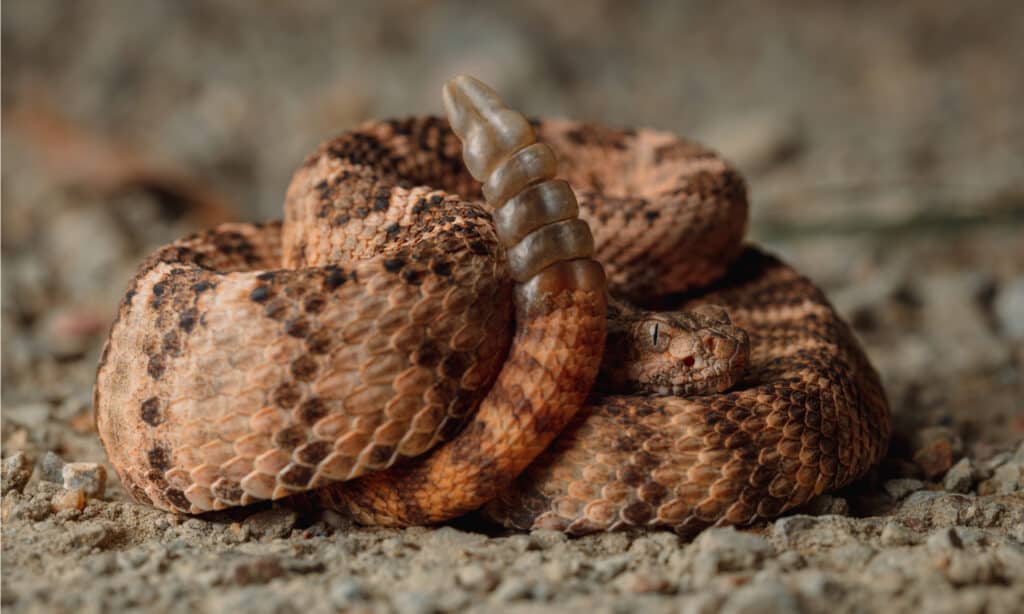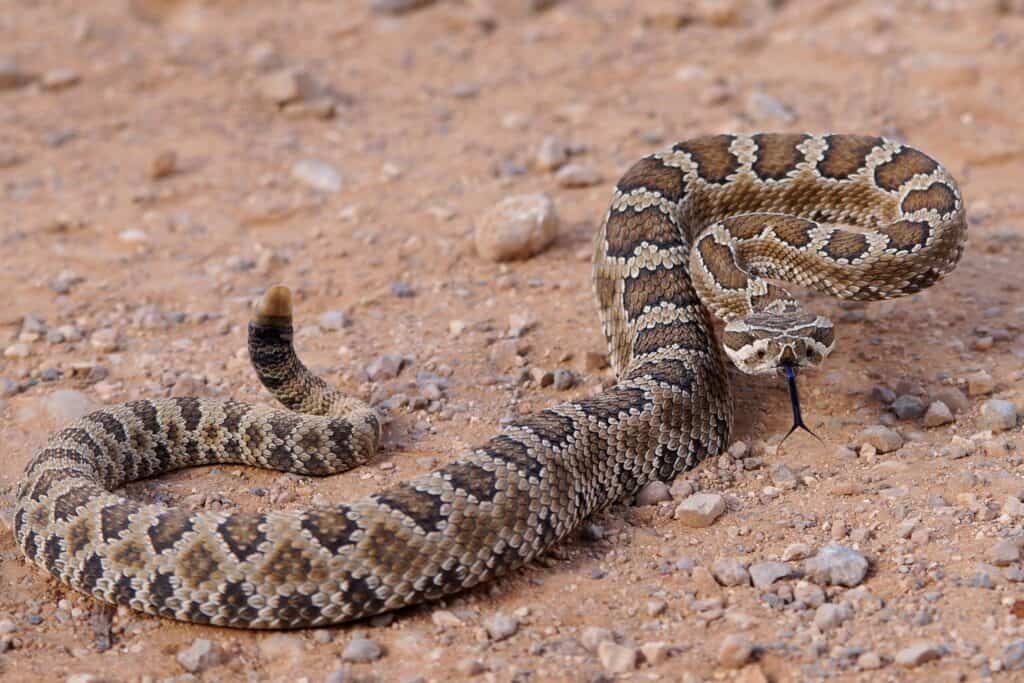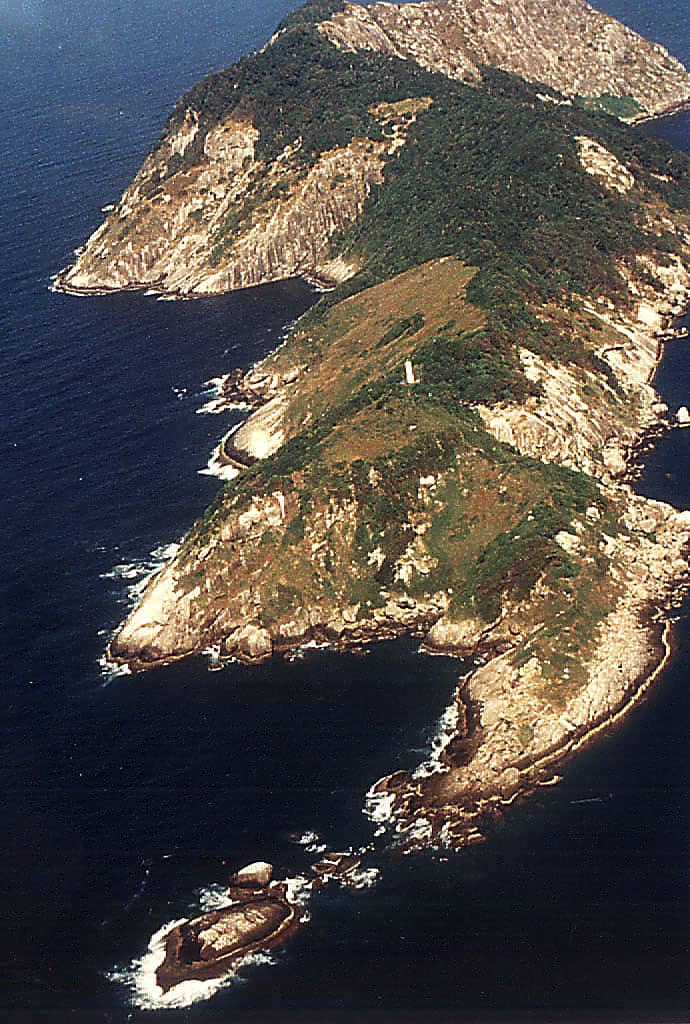Key Points:
- Rattlesnakes are pit vipers found in North and South America that have hemotoxic and neurotoxic venom, making them one of the most dangerous snake species.
- 92 northern Pacific rattlesnakes were discovered under one house’s foundation in 2021 in Sonoma County, California. 81 rattlesnakes (22 adults and 59 babies) were removed in the first visit, then 11 more adults were taken out a second visit.
- These snakes aren’t known to willingly create rattlesnake rookeries in a house that would bring them into such close contact with humans.
Rattlesnakes are venomous pit vipers found in North and South America. There are more than 30 known species of rattlesnakes, which are further divided into more than 65 subspecies. Famous for their keratin rattles and toxic venoms, rattlesnakes are a truly unique species.
Rattlesnakes have hemotoxic and neurotoxic venom, making them one of the most dangerous snake species. The Mojave rattlesnake, for instance, is one of the most venomous snakes in the world. Without a doubt, a rattlesnake is not a snake you’d want to come across unprepared. So you can probably imagine one homeowner’s shock upon discovering not one or 10, but 92 rattlesnakes! Let’s look into the most snake-filled places on Earth.
How Many Rattlesnakes Were Discovered Under One House?

92 rattlesnakes were discovered under one house’s foundation in 2021.
©Alexander Wong/Shutterstock.com
In October 2021, a rather shocking call was placed to the Sonoma County Reptile Rescue, California. One homeowner called to report what they thought to be a large infestation of northern Pacific rattlesnakes (Crotalus oreganus). One of the significant reasons this call shocked attendants was where the snakes had been reportedly seen. The caller allegedly lived in a low-elevation area, and in California, it is uncommon to spot so many snakes at low elevations.
In addition, rattlesnakes aren’t known to willingly inhabit the foundation of a home as that would bring them into close contact with humans. However, the reptile rescue center was quick to send help in the person of Al Wolf, the organization’s rescue director.
Wolf came prepared to excavate a few dozen snakes, but nothing could have prepared him for the actual number. On his first visit, he pulled out 81 rattlesnakes; 22 adults and 59 babies, and on his second visit, 11 more adults.
Why Were 92 Rattlesnakes Discovered Under One House?
According to herpetologist Emily Taylor who works at the California Polytechnic State University (CalPoly) in San Luis Obispo, the homeowner had stumbled upon a rattlesnake rookery.
What Are Snake Rookeries?
You’re probably familiar with snake rookeries in one sense. Many North American snakes are known to hibernate together in burrows and other convenient places underground. These hibernating nests are called rookeries or hibernacula.
However, in 1993, two herpetologists and research scientists, Brent M. Graves and David Duvall, published a study in the Journal of Herpetology. Graves and Duvall’s study was centered on the use of rookeries for reproduction purposes. Sometimes, pregnant snakes gather in large groups to give birth. It is believed that they do this to give their babies a better chance at survival. It isn’t exactly clear why they choose to do this or birth alone. However, it is a sight to see.

Great Basin Rattlesnakes are 2-4 feet long so they aren’t that large but blend into the surroundings very well.
©Matt Jeppson/Shutterstock.com
Rattlesnakes are ovoviviparous, which means that they give birth to their young alive. Previously, it was believed that pit vipers stuck around for about two weeks after birth (oviparous snakes leave right after the eggs hatch). However, Emily Taylor’s research on snake nests proves that this isn’t exactly accurate.
It might be more accurate to say that even after the initial two weeks, mother snakes could occasionally visit to check on her snakes for much longer. She also discovered that snakes born in August might hibernate with their mothers through the winter. Baby rattlesnakes do not begin their separate lives until spring begins.

Rattlesnakes have hemotoxic and neurotoxic venom, making them one of the most dangerous snake species.
©Maria Dryfhout/Shutterstock.com
Is it Normal for Snakes to Live Under Houses?
Yes, it’s fairly common for snakes to make themselves cozy in the crawlspace under your house. In fact, you may never realize they are there unless you happen to come across shredded skin or actually see them. It is not normal for a rookery to be so close in proximity to humans.
Discover the Most Snake-Filled Places on Earth

Ilha de Queimada Grande is a small island, measuring only 106 acres but containing thousands of golden lancehead pit vipers.
©Prefeitura Municipal de Itanhaém / Creative Commons – Original / License
Surprisingly, the snakes evacuated from the California home do not come close to the numbers found in several other places on Earth. One popular example is the Brazilian island of Ilha de Queimada Grande.
Ilha de Queimada Grande is a small island, measuring only 106 acres but containing between 2,000 and 4,000 golden lancehead pit vipers. The island is the only natural home to these critically endangered species of snakes. Golden lanceheads got trapped on the island at the end of the last ice age, which caused the island to separate from the mainland. The snakes adapted to their environment and began to increase in population.
Golden Lanceheads (Bothrops insularis)

As its name hints, the golden lancehead has pale yellowish-brown skin marked with dorsal blotches.
Golden lanceheads are venomous pit vipers that grow between 28 and 35 inches but can occasionally attain 46 inches. As its name hints, the species has pale yellowish-brown skin marked with dorsal blotches that vary in shape and size. However, their bellies are a uniform cream or pale-yellow color.
In captivity, these snakes may lose a bit of the shine in their yellows due to insufficient circulation. They have long heads that are pointy at the nose, which gave rise to the name “lancehead.”
Golden Lancehead Venom
Golden lanceheads are extremely venomous snakes. Because of their isolated habitats that lack mammal prey, these snakes’ venom evolved to be more effective on their present prey, which is mostly migrating birds and native ectotherms.
When golden lanceheads are born, their venom isn’t at its maximum toxicity level. Instead, it becomes stronger and more toxic as they grow. Golden lanceheads have venom that is at least five times more potent than the venom found in the jararaca snake. It is also the fastest-acting venom of the Bothrops genus.
However, there has never been any report of a golden lancehead snake bite because of its habitat. However, judging by the venom of other lanceheads, the mortality rate is 0.5–3% if the victim receives medical treatment and up to 7% if the victim doesn’t.
Some common symptoms of envenomation in the species are swelling, intense pain, dizziness, vomiting, nausea, blood blisters, blood in vomit and urine, kidney failure, intestinal bleeding, bruising, necrosis, and hemorrhaging.
What to Do If You Get Bitten By a Venomous Snake
If you’ve been bitten by a venomous snake, stay calm and exit the snake’s location. Once you’re at a safe distance, call medical emergency services and explain that you’ve been bitten by a venomous snake.
Medical personnel will understand the urgency of your situation and get help to you as fast as possible. While you wait, stay calm. Remember that moving around can cause the venom to circulate faster. Do not attempt to treat yourself by sucking out the blood, cutting off the bitten part, or doing anything else. Instead, stay calm, and wait for medical help.
Discover the "Monster" Snake 5X Bigger than an Anaconda
Every day A-Z Animals sends out some of the most incredible facts in the world from our free newsletter. Want to discover the 10 most beautiful snakes in the world, a "snake island" where you're never more than 3 feet from danger, or a "monster" snake 5X larger than an anaconda? Then sign up right now and you'll start receiving our daily newsletter absolutely free.
Thank you for reading! Have some feedback for us? Contact the AZ Animals editorial team.








